I normally mark Remembrance Day each year, but this year is special.
World War I, the Great War, was not the deadliest war in history. It wanted wasn’t even the second most deadliest.
In a list of total casualties, World War I comes eighth!
So why is so much fuss made about World War I?
World War I was a turning point in human history. Especially in war.
Up until World War I, battles were fought one-on-one, or in small groups. They usually involved only two or three groups of people or countries.
Until the invention of the repeating/loading rifle and pistol, around the time of the American Civil War, the greatest weapon of mass destruction was the canon. Canon were not super-efficient, although they managed to deliver more than their fair share of death.
World War I was different, because it was the first modern war where death and destruction were delivered impersonally, from a distance. By the end of the war, airplanes had learned how to shoot each other down, and drop bombs on people below. Weapons of mass destruction were invented, including chemical weapons that were used in defiance of international treaties.
Tanks were invented, along with howitzer guns, machine guns, and submachine guns.
In addition, World War I drew in combatants from around the world:
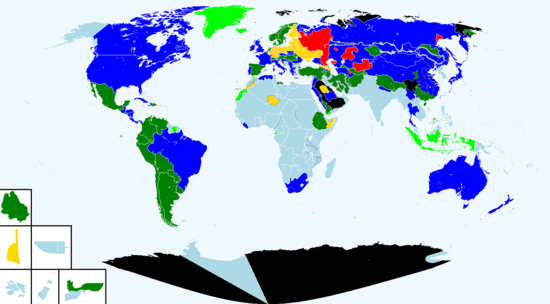
The territories in green are those not involved. As you can see, there’s not a lot of green on the map! (here’s a full list, if you’re curious.)
Before the invention of gunpowder, the only way to kill the enemy was to face him, and use your sword or knife, or bow and arrow. It was very personal.
Which makes the top list of wars in terms of casualties astonishing. Apart from the most deadly war in history, all the other high casualty wars were waged back in history, before guns and weapons of mass destruction were invented.
The second deadliest war, for instance, was the Mongol conquests, which raged across the 13th century and most of the 14th century. Nearly fifty-three million people were killed.
The deadliest war in the history of man was World War Two. World War II delivered sixty million deaths, both civilian and military.
It is estimated that nineteen million people were killed in World War I. It is in the top ten list of deadliest conflict in history. In modern Western military history, it ranks number two. But in terms of the shift in military tactics and the technology of war , and the extent to which it drew in the entire world, World War I is unique.
____
Have you seen the late 19th and early 20th century black and white photos that people have been carefully colouring, to give them a realistic look?
The difference is staggering. Have a look at the original black & white photo compared to the coloured version:
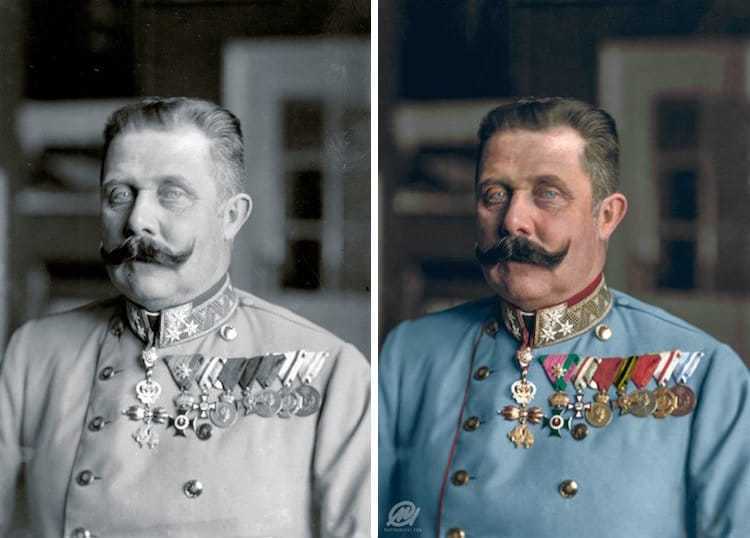
This is the Archduke Franz Ferdinand, whose assassination started the collapse of the house of cards that was Europe’s political structure, and led directly to global war, in 1914.
The original photo doesn’t have nearly the impact that the coloured one does. With colour, suddenly the people in the photos are real. You can empathise with them, imagine them walking and talking.
That brings history alive in a way we’ve not been able to, until now. The very first photographs were taken in the early 19th century, so once they have been retouched, we might
As World War I is today’s subject, here’s some more from the Great War:
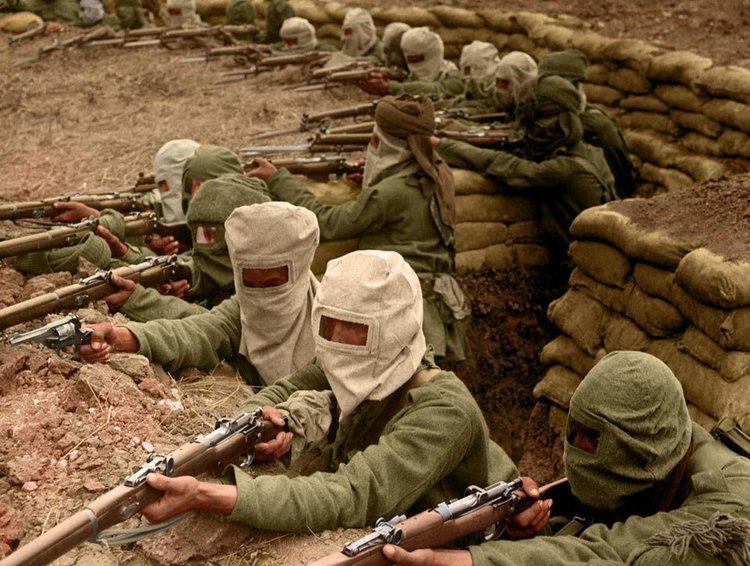
Indian infantry, wearing “gas masks” (honestly, that’s what they used!). It’s creepy how “alive” this looks, isn’t it? You wouldn’t believe this had been taken one hundred years ago. It could be a scene from any of today’s hotspots, except for the antique rifles (and maybe even with the old rifles, too!).

The trenches in France. Although, I think the grass is a bit too green, it still makes the scene come alive.
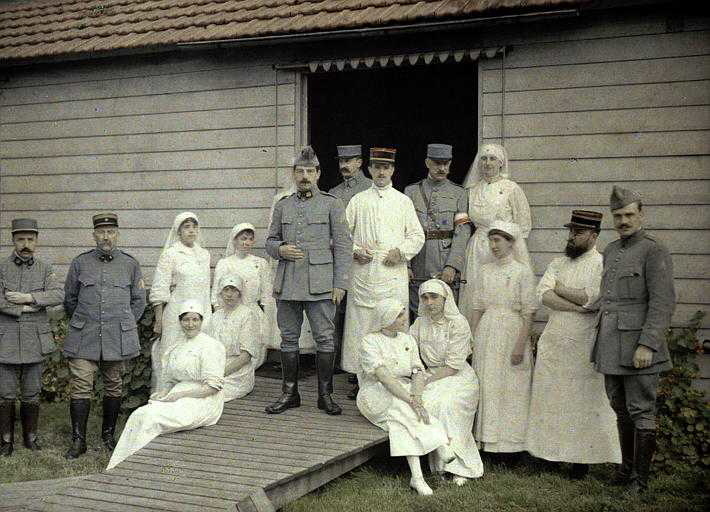
Middle Eastern troops, and nurses. I couldn’t find a tag for this one, but did want to put the nurses in here somewhere.
There are far more re-coloured photos of World War I online. Click here for a Google Search of them.
If you find that fascinating, try general Victorian era photos — and see how a time long past suddenly jumps to life.
Back to the war. Here’s some weird facts about the war to end all wars:
An explosion on the battlefield in France was heard in England.
In Messines Ridge in Belgium, miners detonated over 900,000 lbs of explosives at the same time, destroying the German front line. The explosion was so loud and powerful that it was heard by the British Prime Minister David Lloyd George – 140 miles away in Downing Street.
12 million letters were delivered to the frontline every week.
Even during times of war, it only took two days for a letter to be delivered from Britain to France. A purpose-built mail sorting office was created in Regent’s Park before the letters were sent to the trenches on the frontline. By the time the war ended, over two billion letters and 114 million parcels had been delivered to the trenches!
Plastic surgery was invented because of WW1.
Harold Gillies helped shrapnel victims with terrible facial injuries. He pioneered the early techniques for facial reconstruction.
The youngest British soldier in WW1 was just 12 years old.
Over 250,000 underage soldiers were allowed to fight in World War 1. The youngest was a boy named Sidney Lewis who was just 12 years old but lied about his age to join.
Blood banks were developed during World War I.
It was during WW1 that the routine use of blood transfusion was used to treat wounded soldiers. Blood was transferred directly from one person to another.
Army generals had to be banned from going ‘over the top’.
One common stereotype is that ordinary solders were used by the higher ups – lions led by donkeys as the saying goes. Actually, so many British generals wanted to fight and they had to be banned from going over the top because they were being killed and the experience of a general was too important to lose.
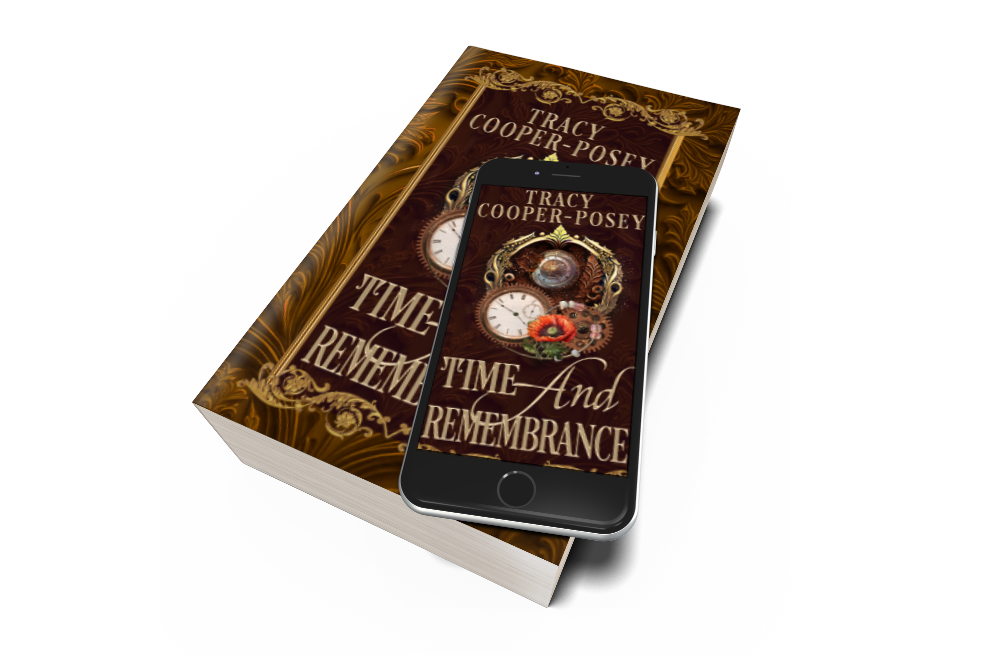
A few weeks ago, the centenary was brought to my attention. As a history nut, I was appalled I had nearly missed this significant date in modern history.
Mark suggested–half-jokingly–that I write a story and publish it on November 11.
It’s not often that I manage to squeeze a bonus story out of my production schedule and spare time, but I really wanted to honor the date, so I sat down with a calendar and started juggling like mad.
I am thrilled I managed it and even more pleased with the story.
Because of the time crunch, I asked Dar Albert, who designs all my covers, to build the cover before I even knew what the story premise was. I knew enough to describe to her what I wanted.
Dar, as usual, read my mind and super-over-delivered. The cover is fantastic–just the right mood and feeling for those last dreadful days in France in 1918.
Here’s the blurb:
A special story marking a moment in history…lest we forget.
On the one hundredth anniversary of Armistice Day, Jesse Hall, United States Marine and unsung hero, finds herself among a group of time-traveling vampires. She has been directed there by a century-old letter from her great-grandfather, instructing her to introduce herself with the phrase: “I’m not wearing a red shirt.”
So begins a dash through time to save a man in the very last minutes of the Great War, which in turn will save eight million other lives…
This novelette is part of the Kiss Across Time paranormal time travel series:
1.0: Kiss Across Time
2.0: Kiss Across Swords
2.5: Time Kissed Moments*
3.0: Kiss Across Chains
4.0: Kiss Across Deserts
5.0: Kiss Across Kingdoms
5.1: Time And Tyra Again*
6.0: Kiss Across Seas
7.0: Kiss Across Worlds
7.1: Time And Remembrance*
8.0: Kiss Across Tomorrow
[*Time Kissed Moments are short stories, novellas and collections which feature the characters and situations from the Kiss Across Time series.]
The series has ongoing storylines and characters. Reading the books in order is recommended.
A Time Travel Vampire Romance Novelette
___
And some early praise:
Another great story by Tracy Cooper Posey. It follows along in the Kiss Across Time series but is a great read all by its self. More than that, it is an important reminder about the horrors of war, not just that experienced by soldiers but by civilians as well. Tracy Cooper-Posey has a gift for making history live enough to touch our minds and to become, just for a moment, real.
I want MORE!!!! For a novella there’s a lot going on. Can a young, but heroic young woman take big step and believe in the unbelievable? The author has given us a look showing us the horrors of war and the fantasy of travelling to the past to make sure a birth occurs that will save 8 million souls in the future. A story filled not with beauty and sensual love, but with the truth and ugliness of war. If we could all learn and remember these truths, just maybe those in power would not begin another.
Once again this series just gets better and better. I can’t wait to read the next one.
Thank you, Tracy, for giving us another opportunity to honor and remember all who serve(d). As usual, you’ve incorporated new facts to learn, new perspectives to ponder and new adventures to enjoy. I love Taylor, Brody and Veris and look forward to traveling in time with them again and again.
Who else, other than Tracy could think to bring out a book in time to join together, with the 100th anniversary of Armistice Day? Brilliant idea, no doubt along side the other books, this one will be a brilliant read too. Can’t wait.
_________
Time and Remembrance is released today, and unlike usual book releases, I am announcing the release simultaneously via my email list and this site, both at the eleventh hour of the eleventh day of the eleventh month.
Excerpt and buy links for Time and Remembrance
Cheers,
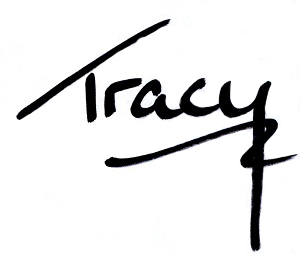
.
Get the news that no one else does. Sign up for my newsletter.
For a short while, you get a bundle of ebooks, free, when you sign up, as a Starter Library. Details here.